Read "DTC Status" parameter.


Knocking is a phenomenon characterized by undesirable vibration and noise that can cause engine damage. A knock sensor (KS) is mounted on the cylinder block and senses engine knocking. A knocking vibration from the cylinder block is applied as pressure to the piezoelectric element. A knock sensor (KS) detects vibration when RPM rises or drops and generates voltages based on this vibration. The PCM controls the ignition timing based on the amplitude and frequency of the knock sensor signal. For example, if engine knocking occurs, the ignition timing is retarded to prevent it.
If normalized reference signal is less than the lower limit based on RPM , P0327 is set.
Item | Detecting Condition | Possible Cause |
DTC Strategy | ● Signal check | ● Poor connection ● Open or short to ground in signal circuit ● Knock sensor |
Enable Conditions | ● Engine speed > 2600rpm | |
Threshold Value | ● Normalized reference level 〈 lower limit, f(rpm) | |
Diagnostic Time | ● Continuous | |
MIL ON Condition | ● DTC only |
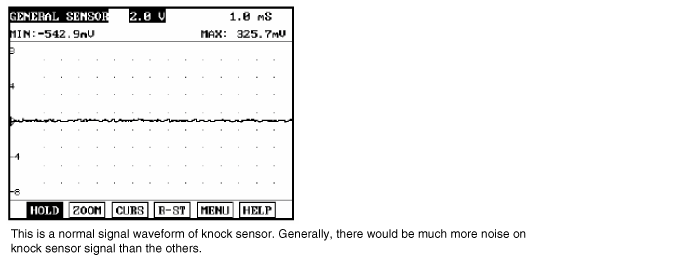
Item | Specification |
Capacitance (pF) | 950 ~ 1,350 |
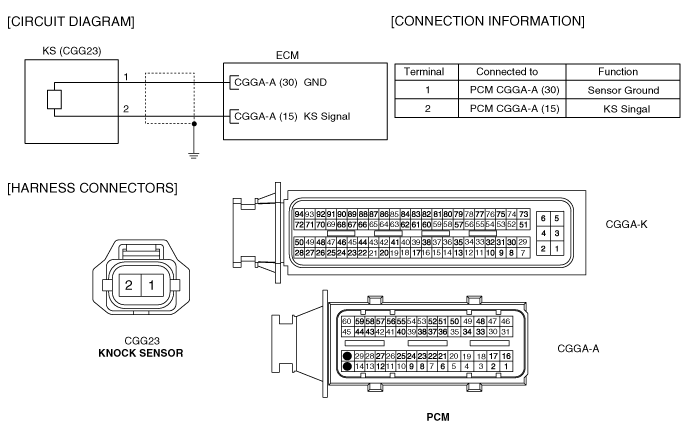
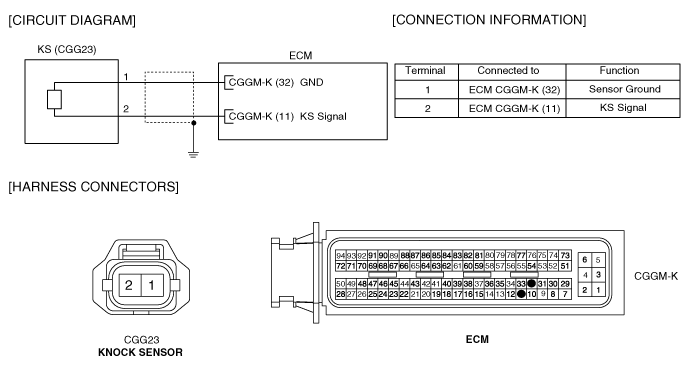
Connect scantool to Data Link Connector(DLC).
IG "ON".
Select "Diagnostic Trouble Codes(DTCs)" mode, and then Press F4(DTAL) to check DTC'sinformation from the DTCs menu
Confirm that "DTC Readiness Flag" indicates "Complete". If not, drive the vehicle within conditionsnoted in the freeze frame data or enable conditions noted in the DTC detecting condition.
Read "DTC Status" parameter.

Is parameter displayed "History(Not Present) fault"?
History fault : DTC occurred but has been cleared.
Present fault : DTC is occurring at present time.

▶ Fault is intermittent caused by poor contact in the sensor’s and/or ECM’s connector or wasrepaired and ECM memory was not cleared. Thoroughly check connectors for looseness,poor connection, bending, corrosion, contamination, deterioration, or damage.Repair or replace as necessary and then go to "Verification of Vehicle Repair" procedure.

▶ Go to "Terminal & Connector Inspection" procedure
Many malfunctions in the electrical system are caused by poor harness and terminals. Faults can also be caused by interference from other electrical systems, and mechanical or chemical damage.
Thoroughly check connectors for looseness, poor connection, bending, corrosion, contamination, deterioration, or damage.
Has a problem been found?

▶ Repair as necessary and go to "Verification of vehicle Repair" procedure.

▶ Go to "Knock sensor circuit inspection" procedure.
Check voltage.
Key "OFF".
Disconnect Knock sensor connector.
Key "ON".
Measure the voltage between terminal 1 of knock sensor harness connector and chassis ground.
Measure the voltage between terminal 2 of knock sensor harness connector and chassis ground.
Specification : Approx 2.4V
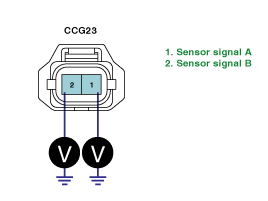
Is the measured voltage within specification?

▶ Go to "Component inspection" procedure.

▶ Go to "Check resistance" procedure.
Check resistance.
Key "OFF".
Disconnect Knock sensor connector and ECM connector.
Measure the resistance between terminal 1 of knock sensor harness connector and 30/CGGA-A of PCM harness connector. [A/T]
Measure the resistance between terminal 2 of knock sensor harness connector and 15/CGGA-A of PCM harness connector. [A/T]
Measure the resistance between terminal 1 of knock sensor harness connector and 32/CGGM-K of ECM harness connector. [M/T]
Measure the resistance between terminal 2 of knock sensor harness connector and 11/CGGM-K of ECM harness connector. [M/T]
Specification : Below 1Ω
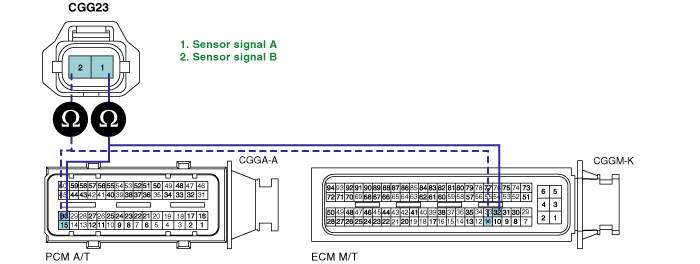
Is the measured resistance within specifications?

▶ Repair Short to ground in signal circuit and then, go to "Verification of Vehicle Repair" procedure.

▶ Repair Open in signal circuit and then, go to "Verification of Vehicle Repair" procedure.
Check Knock sensor.
Substitute with a known - good Knock sensor and check for proper operation.
Is the signal normal?

▶ Replace Knock sensor and go to "Verification of Vehicle Repair" procedure.

▶Many malfunctions in the electrical system are caused by poor harness(es) and terminals. Faults can also be caused by interference from other electrical systems, and mechanical or chemical damage. So, check poor connections and the related circuit between ECM and component thoroughly. Repair as necessary and go to "Verification of Vehicle Repair" procedure.
After a repair, it is essential to verify that the fault has been corrected.
Connect scan tool and select "Diagnostic Trouble Codes(DTCs)" mode.
Press F4(DTAL) and confirm that "DTC Readiness Flag" indicates "Complete".
If not, drive the vehicle within conditions noted in the freeze frame data or enable conditions.
Read "DTC Status" parameter.
Is parameter displayed "History(Not Present) fault"?

▶ System performing to specification at this time. Clear the DTC.

▶ Go to the applicable troubleshooting procedure.